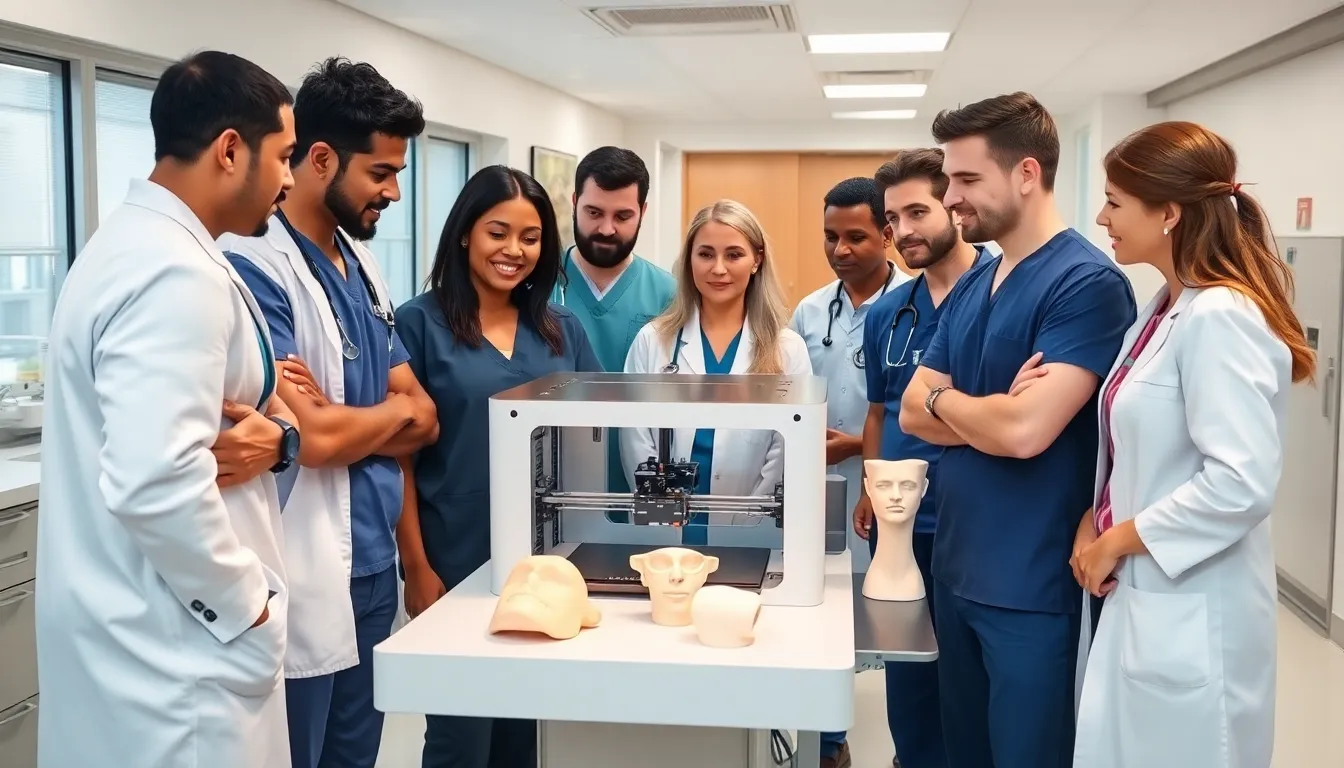In a world where printers are typically reserved for paper and ink, medical 3D printing is turning heads—and not just because it’s printing body parts. Imagine a future where surgeons can create custom prosthetics and implants on-demand, all while sipping their morning coffee. This isn’t science fiction; it’s happening right now, and it’s revolutionizing the way healthcare operates.
Table of Contents
ToggleOverview of Medical 3D Printing
Medical 3D printing utilizes additive manufacturing technology to create patient-specific products. This technology enables the production of custom prosthetics, implants, and other medical devices, made to fit individual anatomical structures. Numerous healthcare professionals benefit from the precision and personalization that 3D printing offers.
Surgeons often use 3D-printed models for preoperative planning. Seeing a tangible representation of a patient’s anatomy aids in strategizing surgical approaches and minimizing risks. Personalized instruments can also be fabricated, enhancing surgical efficiency.
Materials utilized in 3D printing include plastics, metals, and biocompatible materials. Each material serves a specific purpose, influencing the functionality and longevity of the printed devices. Examples of applications vary from dental implants to orthopedic supports, showcasing the versatility of the technology.
Cost savings occur as a significant advantage of using 3D printing in healthcare. Custom solutions can reduce the need for multiple adjustments, leading to less waste and faster turnaround times. Additionally, 3D printing decreases the dependency on conventional manufacturing methods, streamlining production processes.
Research and development in medical 3D printing continue to progress. Innovations aim to improve bioprinting techniques, allowing for the potential creation of tissues and organs. Ongoing clinical trials evaluate the effectiveness and regulatory compliance of these advancements.
Increasing adoption rates mark the current landscape of medical 3D printing. Hospitals and clinics incorporate this technology, transforming patient care through enhanced customization and efficiency. Ultimately, medical 3D printing reshapes the future of healthcare, delivering individualized treatment options tailored to each patient’s unique needs.
Applications of Medical 3D Printing

Medical 3D printing offers a range of applications that significantly enhance healthcare delivery. This technology enables the production of tailored medical solutions.
Prosthetics and Orthotics
Prosthetics and orthotics benefit immensely from 3D printing technology. Custom prosthetic limbs match an individual’s anatomy, ensuring improved comfort and functionality. Adaptive devices, such as orthotics, provide better support and alignment. Costs associated with traditional manufacturing methods decrease, as 3D printing streamlines production. Patients experience quicker turnaround times, often receiving their custom devices within days instead of weeks. The ability to print prototypes also allows for real-time adjustments, enhancing the personalization of each device.
Surgical Planning and Simulations
3D printing enhances surgical planning and simulations significantly. Surgeons use patient-specific models to visualize complex anatomy and improve their strategies before operating. Accurate representations facilitate communication among surgical teams, ensuring everyone understands the procedure. Each model allows for advanced simulations that help identify potential challenges. Surgeons report increased confidence when performing complicated procedures due to these detailed preoperative plans. This technology ultimately leads to lower complication rates and better patient outcomes.
Bioprinting Tissues and Organs
Bioprinting represents a groundbreaking advancement in medical 3D printing. Researchers focus on creating functional tissues and organs to address donor shortages. Using biocompatible materials, bioprinting allows for layered cell structures that mimic natural tissues. These innovations aim to revolutionize transplantation success rates. Early-stage studies highlight potential applications in regenerative medicine, paving the way for future breakthroughs. The continued development of this technology promises to transform how healthcare professionals approach treatment and patient care.
Benefits of Medical 3D Printing
Medical 3D printing offers significant advantages that are revolutionizing healthcare practices. Key benefits include customization, cost reduction, and improved efficiency.
Customization and Personalization
Customization and personalization stand at the forefront of medical 3D printing. Healthcare providers create patient-specific prosthetics and implants, ensuring a perfect fit for individual anatomical features. Models crafted from imaging data allow surgeons to plan procedures tailored to a patient’s unique needs. Personalization enhances patient comfort, leading to higher satisfaction rates. Custom devices outperform conventional options in both function and aesthetics, improving overall treatment experiences. Moreover, advancements in materials used, such as biocompatible substances, enable the design of personalized replacements that work harmoniously with the body, further enhancing patient outcomes.
Reduced Costs and Time Efficiency
Reduced costs and improved time efficiency mark major benefits of medical 3D printing. Patients experience shorter wait times for custom devices, thanks to on-demand production capabilities that eliminate traditional manufacturing delays. Cost savings arise from minimizing waste during the production process; materials are used precisely without excess. Facilities benefit from streamlined workflows that don’t require extensive inventories of prefabricated items. This technology reduces the expenses associated with logistics and shipping, since items can be produced closer to where they’re needed. Overall, medical 3D printing creates a more cost-effective approach while delivering quicker solutions for patient care, enhancing both accessibility and satisfaction.
Challenges and Limitations
Medical 3D printing faces several challenges and limitations that must be addressed for continued innovation and application in healthcare.
Regulatory and Ethical Considerations
Regulatory hurdles often slow the adoption of medical 3D printing. Organizations such as the FDA establish standards to ensure safety and efficacy, creating a complex approval process for new materials and devices. Ethical concerns arise regarding customization and ownership, particularly with bioprinting, as patient privacy and consent must remain a priority. As technology evolves, regulatory frameworks need ongoing updates. Ensuring compliance with existing laws while accommodating innovation proves difficult.
Material Limitations and Quality Control
Material selection significantly affects the performance and durability of 3D-printed products. Various materials, such as thermoplastics, metals, and biocompatible substances, each present unique properties that influence their suitability for specific applications. Quality control measures become paramount, as inconsistencies can lead to device failure. Post-processing techniques also play a vital role in ensuring product quality. Implementing regular testing protocols helps maintain standards throughout production, but challenges remain in establishing universal guidelines across the industry.
Future Trends in Medical 3D Printing
Advancements in medical 3D printing continue to drive innovations in patient care. Personalized treatment options represent a significant trend, with an increasing demand for custom implants tailored to individual anatomies. Researchers explore bioinks for bioprinting, aiming to create functional tissues and organs, addressing the pressing issue of donor shortages.
Increased integration of artificial intelligence enhances the design and manufacturing processes within medical 3D printing. AI algorithms analyze patient data, leading to more accurate modeling and production timelines. Furthermore, the rise of point-of-care 3D printing enables on-site fabrication, reducing wait times for patients in urgent need.
Regulatory bodies are evolving to accommodate medical 3D printing technologies. Agencies aim to streamline the approval processes for new devices, ensuring patient safety while promoting innovation. Additionally, collaborations between manufacturers and healthcare providers empower more efficient standards and practices.
Sustainability emerges as a vital trend as well. Emphasis on eco-friendly materials and processes minimizes waste, aligning with global sustainability goals. Advancements in print materials expand the possibilities for biocompatibility and function in diverse medical applications.
Technology advancements significantly improve cost-effectiveness in medical 3D printing. With reduced production times and waste, healthcare systems experience savings while meeting patient needs. Customization becomes more accessible, enhancing the overall efficiency of treatment solutions.
These trends reflect the ongoing transformation in healthcare due to medical 3D printing. Enhanced patient outcomes, regulatory progress, and innovations in materials and processes pave the way for a brighter future in personalized medicine.
Medical 3D printing is revolutionizing healthcare by enabling personalized solutions that enhance patient care. Its ability to create custom prosthetics and implants on-demand is just the beginning. As technology advances the focus on sustainability and efficiency will continue to shape the future of medical practices.
The integration of AI and bioprinting holds promise for even greater innovations in tissue engineering and regenerative medicine. With ongoing research and development the potential for improved patient outcomes is significant. As regulatory processes adapt and streamline the adoption of this groundbreaking technology will likely accelerate, paving the way for a new era in personalized medicine.





